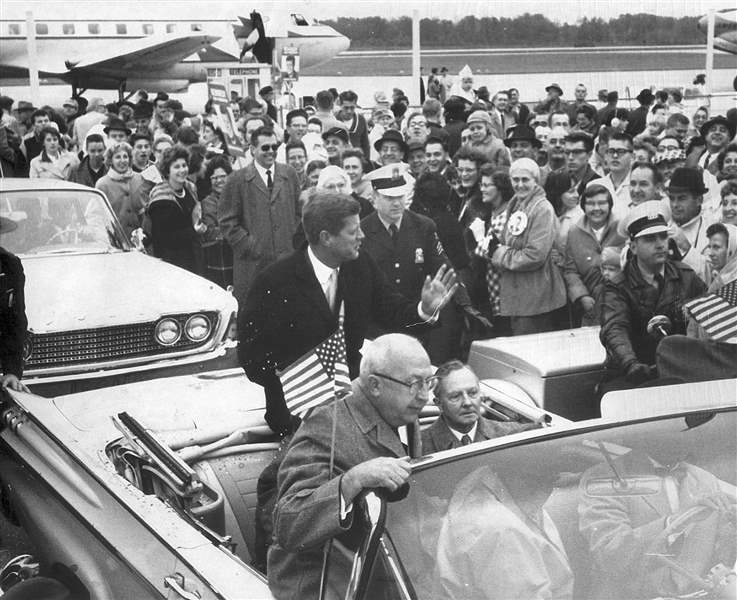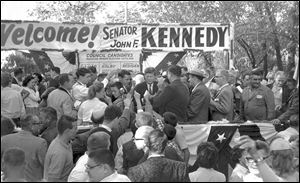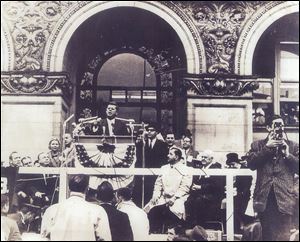
How JFK left mark on Toledo
Throngs packed downtown during ’60 campaign stop of Kennedy, who would have turned 100 Monday
5/28/2017
Sen. John F. Kennedy (D., Mass.) waves to onlookers after landing at Toledo Express Airport during the 1960 presidential campaign.
THE BLADE
Buy This Image
The John F. Kennedy who was born 100 years ago Monday left a legacy that historians still debate.
The U.S. senator from Massachusetts came to Toledo in 1956 to campaign for Democratic presidential nominee Adlai Stevenson, while laying the political groundwork for his own campaign four years later.
According to The Blade’s report, Mr. Kennedy addressed 3,500 spectators in the former Sports Arena in East Toledo.
His second trip took place Sept. 19, 1959, to an ox roast at a place called Katty’s Grove on Hill Avenue where — still undeclared as a candidate for president — Mr. Kennedy addressed an estimated 10,000 people.
In that speech, he waded into a local controversy that had Toledo city council members split — a ballot issue to change from a city-manager to strong-mayor government.
As charismatic as Mr. Kennedy was, Toledo voters defeated the measure on Nov. 3, 1959.
VIDEO: Blade Briefing on JFK’s stops in Ohio
Toledo campaign stop
After he won the Democratic nomination to run against Republican Richard Nixon, Mr. Kennedy campaigned six times in Ohio, his last one in Toledo on Nov. 4, 1960, just four days before the election.

John F. Kennedy was photograped by Herral Long in 1959 in Toledo,OH Blade photo
The candidate flew into Toledo Express Airport. His 18-car motorcade wended through South Toledo into downtown Toledo where a crowd estimated at up to 25,000 jammed Courthouse Square.
Mr. Kennedy called for economic planning that would create millions of new jobs, and fired political jabs at Mr. Nixon.
He made a prediction that turned out not to be true:
“Whoever carries Ohio will carry the United States,” Mr. Kennedy said.
In fact, Mr. Nixon carried Ohio, beating Mr. Kennedy by more than 273,000 votes — many believe because of a radio commercial recorded for Mr. Nixon by Ohio State University football coach Woody Hayes. That was the last time Ohio voted for the loser of the electoral college vote.
Personal accounts
On leaving the downtown, Mr. Kennedy followed a route through West Toledo and Ottawa Hills. Along the way he was seen by a young Sandy Isenberg, who was living on Bancroft Street.
“I was in the upstairs apartment, young, married, pregnant, and this gorgeous hunk comes driving down the street in a Cadillac convertible [with] reddish hair,” Ms. Isenberg said.
Mr. Kennedy “was the first person I ever voted for,” the former Democratic Lucas County commissioner said.
“He’s really the one who brought young people into the party that wanted to do things,” Ms. Isenberg said.
Also on that outbound trip occurred an incident that would have eerie overtones three years later. Someone threw a tomato that splattered on Mr. Kennedy’s windshield.
Governor Michael DiSalle, a former Toledo mayor, said the unidentified tomato thrower was a “sub deb,” a teenage girl not old enough to become a debutante. He quipped that “her timing was off.”
Robert Waters, a history professor at Ohio Northern University who has written about President Kennedy, said driving in a convertible was Mr. Kennedy’s choice.
“He always preferred convertibles because he wanted people to see him. People would say this is dangerous and he would say, ‘if an assassin wants to get me, he’ll find a way,’ ” Mr. Waters said.

President John F. Kennedy speaks at a campaign rally outside the Lucas County Courthouse on Nov. 4, 1960. Crowds packed the downtown square to see him.
One of the enthusiastic Democrats who remembers being in the crowd that day was Jerry Chabler, a Toledo policeman, later to become a Democratic Party operative.
“I don’t remember verbatim what he said but it was very, very powerful. It was a huge crowd,” Mr. Chabler said. “The short time that he was in office he had the potential of becoming the greatest President we ever had but unfortunately he was cut down and he never got a chance to show his full potential.”
That was Mr. Kennedy’s third and last known trip to Toledo. But he was not done with Toledo.
In February, 1961, he fired off a telegram to Toledo Mayor Mike Damas, urging him to pick up the pace of urban renewal for which federal funds had been authorized. Among the projects mentioned were Chase Park residential renewal and Ironville industrial renewal.
Mr. Kennedy was killed as he drove in an open convertible on Nov. 22, 1963 in Dallas.
Early life of JFK
The former president was born in Brookline, Mass., the son of wealthy businessman Joe Kennedy, Sr., and Rose Kennedy, daughter of a prominent Boston politician.
Competitive, handsome, and a promising writer, Navy Lieutenant Kennedy received a Purple Heart after the boat he commanded in the Pacific Theater of World War II, the PT-109, was destroyed in a collision with a Japanese ship and he helped save his crew.
Mr. Kennedy was elected to the U.S. House of Representatives in 1946 and to the U.S. Senate six years later.
According to Professor Waters, “he had some kind of vitality that people could feel.
“He got the huge crowds like nobody else was getting in 1960. We didn’t have the term at the time but he really was the first president candidate who’s kind of a rock star,” Mr. Waters said.
100th birthday
Professor Waters said he has been struck by the modest level of attention that Mr. Kennedy’s 100th birthday is getting. He thinks it may be, in part, because of the difference in ideology between JFK and the current Democratic Party.
“The Democrats have gotten pretty far away from Kennedy’s vision. He tried to push through a tax cut, a pretty big one. He was for a pretty vigorous foreign policy. You don’t see that much in Democrats anymore. I’ve been shocked at how little coverage there’s been of his 100th birthday,” Mr. Waters said.
Kennedy’s politics
Alvin Dwayne Beggs, a history professor at Lourdes University in Sylvania, said Mr. Kennedy was his own man and said there is reason to believe his views were evolving.
“He was a Democrat and he certainly had Democrat leanings, supported the Democratic platform. But I also think he was an individual who did what he thought was the best and that didn’t necessarily line up with the party,” Mr. Beggs said.
On Vietnam, Mr. Kennedy decided to make that former French colony a line in the sand against Communism, pouring in American military advisers and troops to prop up the pro-United States government.
He wavered on civil rights, but is believed to have been moving in that direction.
“He did not want to alienate Southern Democrats, but he does try to enact some civil rights legislation. When he dies, Lyndon Baines Johnson picks up the torch of some of the things Kennedy wanted to do,” Mr. Beggs said. “The card that President Johnson plays is, ‘this is what our beloved slain President wanted.’ That’s impacted us today.”
Mr. Kennedy was the first Catholic president, but only after he went to a group of Protestant ministers in Houston to make it clear that the Pope was not going to call the shots.
Toledo theologian the Rev. James Bacik said he saw Mr. Kennedy as likely to have emerged the champion of civil rights and scale back U.S. involvement in Vietnam.
“I always felt he would have gotten us out of Vietnam on pragmatic grounds. He was not an ideologue, for sure,” Father Bacik said.
Contact Tom Troy: tomtroy@theblade.com or 419-724-6058 or on Twitter @TomFTroy.